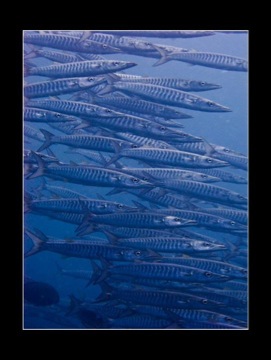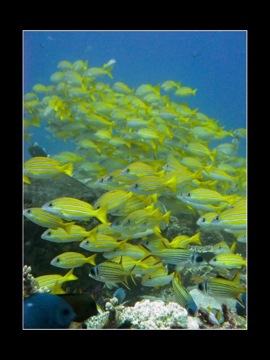Where the predators come to play
02/09/11 13:07

The Gili islands northwest of Lombok are often known for their friendly turtles and the colourful reefs where many tourists take their first underwater breaths. But for Advanced-level divers – or those who want to become one – sites like Jack Point, Deep Turbo and Mirko’s Reef offer unique animals, stunning coral, a huge array of fish and some serious predators.
I’m feeling ready for adventure and the staff at Gili Air Divers (a French/Spanish/Indonesian shop that’s now opening Gili Meno Divers as well) promise me small diving groups, new rental equipment, personal service and an eagle-eyed guide, so I decide to sign on for a morning at Jack Point.
We leave Gili Air’s beach behind and set off to the site just north of Gili Trawangan. We gear-up, jump in and descend. It’s only moments later that I find myself next to a hurricane of silvery-blue fish. Schools of barracuda and jack fish swirl and swoop. Under us, blue-spotted rays weave through hundreds of tall whip corals, each reaching up like an arm from below. We are all pointing in different directions; there’s just too many places to look!
It takes a bit of work to stay in this spot, fighting the current 27 meters below the surface. But the current is a good thing; it’s what brings the predators out to play. And when the black-tipped reef shark blows gracefully through the center of the hurricane, I know it’s worth the extra kicks.
After a few minutes, we rest our legs and go with the current, slowing moving up the slope that connects this dive location to Shark Point, a well-known site popular with divers at both the Open Water and Advanced Open Water levels.

Soon, we see some dark forms ahead. And they’re big. Table-sized. It’s another couple minutes before we arrive up close. Their tiny eyes pay us no attention as they continue breaking apart coral, their ridiculous mouths and humped heads making them look like awkward teenagers. Beautiful green scales help distinguish them as part of the parrotfish family – we’ve all seen their relatively tiny cousins while snorkelling – but the bumphead parrotfish is a creature all its own. For once, the camera-carrying divers are happy to have other people in some of their pictures; it helps to show just how big these fish are.
Our guide gives us time to enjoy these bizarre animals before we continue up the slope, swimming over and around coral boomies surrounded by over-sized versions of my favourites: sweetlips, angelfish and batfish. We are all looking for more sharks, moray eels, octopus or a slithering snake eel, but almost every time, it’s our guide who first spots the treasure.
The dive ends in an area full of pink coral five meters deep, where the famous green and hawkbill turtles both make appearances. They are searching for lunch, but it’s a much calmer hunt than the one we saw further below!
After slowly surfacing, it’s clear our guide has three ecstatic divers on his hands. Two are already reliving memories of the predators. But for me, it was the bumpheads who stole the show. Gili Air Divers’ bran new boat comes around the pick us up, and as I pass my equipment up to one of the crew, he asks me if I want to go out again this afternoon. My hammock-time plans have just changed, and I let him know, “Definitely.”




